Defytime is the only company publishing test results of people using and taking supplements containing the telomerase inducing activator TAM. The below test cases show how the effects have been remarkable with telomere length increased and biological age reduced sometimes dramatically.
Defytime is the only company publishing test results of people using and taking supplements containing the telomerase inducing activator TAM. The below test cases show how the effects have been remarkable with telomere length increased and biological age reduced sometimes dramatically.
Chronological vs Biological Aging
Your chronological age is the amount of time in terms of years, months, days, etc that has passed from your birth to a given date. This is the primary way people define their age.
Your biological age depends on a number of variables that can change on a continuing basis including genetics, lifestyle, nutrition, diseases and other conditions. Using these guidelines, medical professionals can figure out what age your body ‘acts’ like it is.
The difference between the two can be surprising.
Telomere Analysis Technology
Telomere analysis is done by blood test and measures telomere length in order to accurately evaluate the body’s biological age.
The TAT (Telomere Analysis Technology) test is a biomarker that enables risk assessment and early prognosis of various diseases including cancer, by comprehensively analysing, and appropriately evaluating telomere length that is a factor of age-related diseases.
Time-series analysis
Comparison of first and second test results using TAM Spray
2020
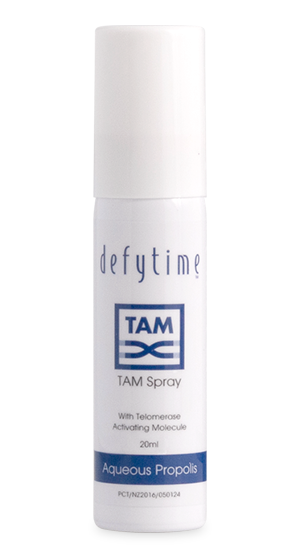
Time-series analysis
Comparison of first and second test results using TAM Spray
2020

Male aged 49 years
First and second test results show estimated biological age reduced by 3.2 years


| TAT Test | Chronological Age | Sex | Estimated Biological Age | Difference with Chronological Age | Difference with last test | Median | 20th Percentile |
|---|---|---|---|---|---|---|---|
| First | 49.4 | Male | 52.8 | +3.4 | 10.2Kb | 5.4Kb | |
| Second | 49.9 | 49.6 | -0.3 | 3.2 years younger | 10.8Kb | 5.4Kb |
Female aged 67 years
First and second test results show estimated biological age reduced by 4.6 years

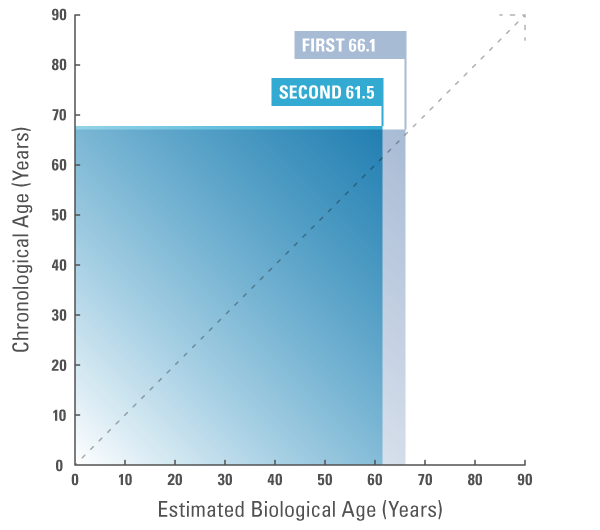
| TAT Test | Chronological Age | Sex | Estimated Biological Age | Difference with Chronological Age | Difference with last test | Median | 20th Percentile |
|---|---|---|---|---|---|---|---|
| First | 67.1 | Female | 66.1 | -1.0 | 10.2Kb | 5.4Kb | |
| Second | 67.8 | 61.5 | -6.3 | 4.6 years younger | 11.0Kb | 5.7Kb |
Shop now for Defytime TAM Spray
Time-series analysis
Comparison of first and second test results using TAM Capsules
2020
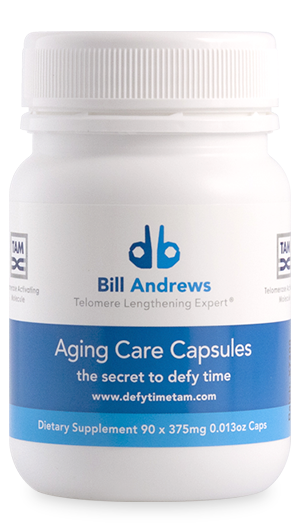
Time-series analysis
Comparison of first and second test results using TAM Capsules
2020

Female aged 36 years:
First and second test results show estimated biological age reduced by 4.8 years.

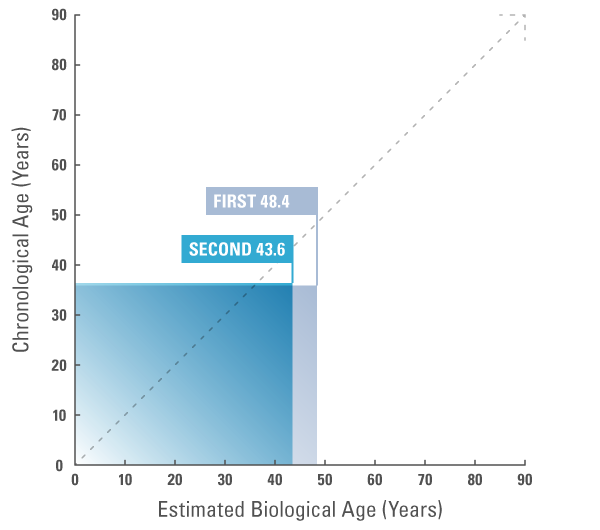
| TAT Test | Chronological Age | Sex | Estimated Biological Age | Difference with Chronological Age | Difference with last test | Median | 20th Percentile |
|---|---|---|---|---|---|---|---|
| First | 35.9 | Female | 48.4 | +12.5 | 9.3Kb | 4.3Kb | |
| Second | 36.4 | 43.6 | +7.2 | 4.8 years younger | 10.1Kb | 5.1Kb |
Female aged 62 years
First and second test results show estimated biological age reduced by 2.5 years.

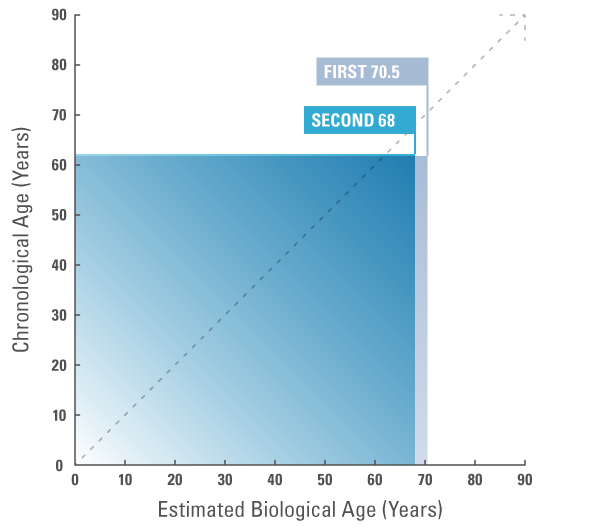
| TAT Test | Chronological Age | Sex | Estimated Biological Age | Difference with Chronological Age | Difference with last test | Median | 20th Percentile |
|---|---|---|---|---|---|---|---|
| First | 61.8 | Female | 70.5 | +8.7 | 8.2Kb | 3.6Kb | |
| Second | 62.2 | 68 | +5.8 | 2.5 years younger | 9.3Kb | 4.7Kb |
Shop now for Defytime Bill Andrews Aging Care Capsules
Questions about Telomere Analysis
What is the relationship between biological age and chronological age that we can learn from our telomeres?
Not all individuals age at the same rate even though they may have the same chronological age. Therefore, it is important to identify molecular markers (other than chronological age) that can estimate the degree of aging of an organism. This information is useful for health professionals and individuals alike to anticipate premature development of age-related issues and to try to consider changes in lifestyle (for instance, obesity and smoking have been shown to accelerate telomere attrition while exercise and good nutrition slow it), to follow more closely our telomere dynamics over the years, or to benefit from potential telomerase activators. Mounting evidence suggests that the length of telomeres is a good indicator of the degree of aging of an organism.
What are the factors that affect the length of my telomeres?
Genetics and lifestyle are fundamental factors that affect telomere length and the rate at which they shorten. Certain life habits have been significantly associated with having longer or shorter telomeres. For example, smoking, obesity and psychological stress increase oxidative stress and inflammation which, in turn, contribute to higher rates of telomere attrition throughout life. Other factors such as diet, exercise, sleep are also believed to impact biological aging. Current therapies are being developed based on telomerase activation to rejuvenate telomeres. Measuring telomere length will be necessary to determine whether these therapies are effectively improving telomere length.
Why do I need to know my biological age?
Firstly, it is an excellent indicator of an individual overall general health status. Secondly, knowing our biological age, it permits us to obtain a better understanding of the lifestyle habits that impact aging and affords us the opportunity to make appropriate changes and by periodic re-testing, measure the results. Thirdly, Life Length’s Telomere Analysis Technology (TAT), will allow for more personalized medicine as doctors treat patients increasingly taking into consideration their biological age.
How is my biological age calculated?
Biological age is calculated using a mathematical formula which takes into consideration the individual’s chronological age group which is then weighted by their telomere length results.
How often should I get my telomeres measured?
We recommend that individuals interested in monitoring their telomere length repeat the measurement annually, although periods of six months may be considered for individuals making significant lifestyle changes.
Why does Life Length emphasize the median telomere length rather than the average (mean) value?
Telomere length varies within each single cell, such that each chromosome end has a different length of telomeric repeats (there are 2 telomeres per chromosome and 23 pairs of chromosomes per cell). Average telomere length is the mean length of all telomeres considered together, usually within a population of cells (not even per individual cell). However, as the telomere length distribution of the cells is not symmetrical, the median telomere length is more representative of this distribution rather than the mean.
What is the difference between median telomere length and the 20th percentile and why is this important?
The median telomere length represents the 50th percentile in the distribution of cell telomere lengths. In contrast, the 20th percentile indicates the telomere length below which 20% of the observed telomeres fall. As such it is an estimator of the percentage of short telomeres in the cells. This is important because mounting scientific evidence shows that it is the short telomeres that are responsible for causing aging and the collateral effects of aging. This is because critically short telomeres inflict permanent and deleterious damage to the cell, unless they are repaired by telomerase. Therefore, to be able to evaluate whether telomeres are prematurely short for a given chronological age it is necessary to use techniques that allow quantification of the abundance of short telomeres. Just measuring average or median telomere length of a population of cells is not sufficient to identify premature telomere shortening. The superiority of the technology commercialized by Life Length is based on our ability to precisely measure telomeres individually, allowing for the quantification of short telomeres.
Disclaimer
- No Guarantee of Results: Defytime makes no guarantees with regard to the amount of telomere length increase or health benefit a client may achieve.
- Results will vary depending on the health condition and lifestyle of each individual.
- Further information about the people who were tested is confidential to protect their privacy.
- The information and graphical diagrams presented are copyrighted to Defytime Limited.
